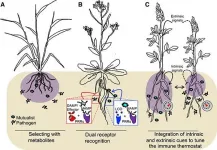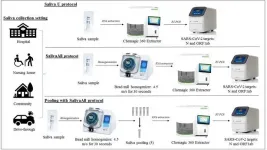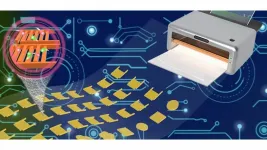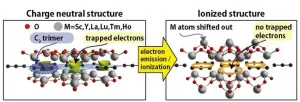Queqiao: The bridge between Earth and the far side of the moon
Researchers explain the design of the relay communication satellite that enabled us to peek at the hidden face of the moon
2021-06-10
(Press-News.org) Because of a phenomenon called gravitational locking, the Moon always faces the Earth from the same side. This proved useful in the early lunar landing missions in the 20th century, as there was always a direct line of sight for uninterrupted radiocommunications between Earth ground stations and equipment on the Moon. However, gravitational locking makes exploring the hidden face of the moon--the far side--much more challenging, because signals cannot be sent directly across the Moon towards Earth.
Still, in January 2019, China's lunar probe Chang'e-4 marked the first time a spacecraft landed on the far side of the Moon. Both the lander and the lunar rover it carried have been gathering and sending back images and data from previously unexplored areas. But how does Chang'e-4 probe communicate with the Earth? The answer is Queqiao, a relay communications satellite, explains Dr. Lihua Zhang from DFH Satellite Co., Ltd., China.
As explained by Dr. Zhang in a review paper recently published in Space: Science & Technology, Queqiao is an unprecedented satellite designed specifically for one purpose: to act as a bridge between Chang'e-4 probe and the Earth. Queqiao was launched in 2018 and put into orbit around a point 'behind' the Moon. This point is known as the Earth-Moon Libration point 2, where a special case of gravitational balance allows Queqiao to maintain an orbit such that it has almost constant direct line of sight with both the far side of the Moon and the Earth. Getting the satellite into this peculiar orbit required careful planning and maintenance management, and the success of this operation set a precedent for future attempts at putting satellites in orbit around other Earth-Moon libration points.
From its stable place in space, Queqiao helped guide the soft-landing and surface operations of Chang'e-4 probe and has been our intermediary with it ever since. The satellite is equipped with two different kinds of antennas: a parabolic antenna and several spiral antennas. The former, which has a large diameter of 4.2 m, was designed to send and receive signals on the X band (7-8GHz) to and from the rover and lander on the surface of the Moon. Its large size is related the expected noise levels and the low intensity of the transmissions that are sent by surface equipment.
On the other hand, the spiral antennas operate on the S band (2-4 GHz) and communicate with Earth ground stations, forwarding commands to the lunar surface equipment and exchanging telemetry and tracking data. Most notably, all these different links can transmit and receive simultaneously, making Queqiao highly versatile. The review paper addresses other important design considerations for Queqiao and future relay satellites, such as the use of regenerative forwarding, the various link data rates involved, and data storage systems for when no Earth ground station is accessible.
Over two years of exploration, a great amount of data has been received from the rover and lander through Queqiao. "Scientists in both China and other countries have conducted analysis and research based on the retrieved data, and they have produced valuable scientific results. The longer the operational life of Queqiao, the more scientific outcomes will be achieved," remarks Dr. Zhang. Based on current predictions, Queqiao should be operable on mission orbit for at least five years.
Dr. Zhang also addressed the prospects for future lunar missions and how relay communication systems should evolve to support them. Many unexplored areas on the Moon, such as the largest crater at the South Pole, call for multiple relay satellites to maintain constant communication links, which poses an expensive and time-consuming challenge. But what if relay satellites were suitable for more than a single mission? "A sustainable communication and navigation infrastructure should be established to benefit all lunar missions rather than dealing with each mission independently," comments Dr. Zhang, "This infrastructure should adopt an open and extensible architecture and provide flexible, interoperable, cross-supportable, and compatible communications services, which are critical to the success of future lunar explorations." It's likely that future endeavors on the far side of the Moon will be a test on how well we can cooperate to unveil the secrets of our natural satellite.
INFORMATION:
Reference
Author: Lihua Zhang
Title of original paper: Development and Prospect of Chinese Lunar Relay Communication Satellite
Article link: https://spj.sciencemag.org/journals/space/2021/3471608/
Journal: Space: Science & Technology
DOI: https://www.doi.org/10.34133/2021/3471608
Affiliations: DFH Satellite Co., Ltd.
About Dr. Lihua Zhang
Dr. Lihua Zhang is a spacecraft system engineer who serves as a Project Manager at DFH Satellite Company Ltd, China. He is the chief designer and project manager of Queqiao lunar relay communication satellite.
[Attachments] See images for this press release:
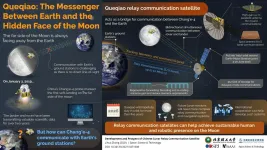
ELSE PRESS RELEASES FROM THIS DATE:
2021-06-10
Philadelphia, June 10, 2021 - A new study from researchers at Children's Hospital of Philadelphia (CHOP) and the University of Pennsylvania's Annenberg Public Policy Center found that 18- to 24-year-olds who use cell phones while driving are more likely to engage in other risky driving behaviors associated with "acting-without-thinking," a form of impulsivity. These findings suggest the importance of developing new strategies to prevent risky driving in young adults, especially those with impulsive personalities. The study was recently published in the International Journal of Environmental Research Public Health.
Cell phone use while driving has been linked to increased crash and near-crash risk. Despite bans on handheld cell phone use ...
2021-06-10
Plants are constantly exposed to microbes: pathogens that cause disease, commensals that cause no harm or benefit, and mutualists that promote plant growth or help fend off pathogens. For example, most land plants can form positive relationships with arbuscular mycorrhizal fungi to improve nutrient uptake. How plants fight off pathogens without also killing beneficial microbes or wasting energy on commensal microbes is a largely unanswered question.
In fact, when scientists within the field of Molecular Plant-Microbe Interactions were asked to come up with their Top 10 Unanswered Questions, the #1 question was "How do plants engage with beneficial microorganisms while at the same time restricting ...
2021-06-10
MORGANTOWN, W.Va. -- Imagine being woken up at 3 a.m. to navigate a corn maze, memorize 20 items on a shopping list or pass your driver's test.
According to a new analysis out of West Virginia University, that's often what it's like to be a rodent in a biomedical study. Mice and rats, which make up the vast majority of animal models, are nocturnal. Yet a survey of animal studies across eight behavioral neuroscience domains showed that most behavioral testing is conducted during the day, when the rodents would normally be at rest.
"There are these dramatic daily fluctuations--in metabolism, in immune function, in learning and ...
2021-06-10
Philadelphia, June 10, 2021 - The collection of nasopharyngeal swab (NPS) samples for COVID-19 diagnostic testing poses challenges including exposure risk to healthcare workers and supply chain constraints. Saliva samples are easier to collect but can be mixed with mucus or blood, and some studies have found they produce less accurate results. A team of researchers has found that an innovative protocol that processes saliva samples with a bead mill homogenizer before real-time PCR (RT-PCR) testing results in higher sensitivity compared to NPS samples. Their protocol appears in The Journal of Molecular Diagnostics, published by Elsevier.
"Saliva as a sample type for COVID-19 testing ...
2021-06-10
WASHINGTON, June 10, 2021 -- The demand for flexible wearable electronics has spiked with the dramatic growth of smart devices that can exchange data with other devices over the internet with embedded sensors, software, and other technologies. Researchers consequently have focused on exploring flexible energy storage devices, such as flexible supercapacitators (FSCs), that are lightweight and safe and easily integrate with other devices. FSCs have high power density and fast charge and discharge rates.
Printing electronics, manufacturing electronics devices and systems by using conventional printing techniques, has proved to be an economical, simple, and scalable strategy for fabricating FSCs. Traditional micromanufacturing ...
2021-06-10
An exploratory investigation into the behavior of materials with desirable electric properties resulted in the discovery of a structural phase of two-dimensional (2D) materials. The new family of materials are electrides, wherein electrons occupy a space usually reserved for atoms or ions instead of orbiting the nucleus of an atom or ion. The stable, low-energy, tunable materials could have potential applications in nanotechnologies.
The international research team, led by Hannes Raebiger, associate professor in the Department of Physics at Yokohama National University in Japan, published their results on June 10th as frontispiece in Advanced Functional Materials.
Initially, the team ...
2021-06-10
Researchers from Skoltech have designed and conducted experiments measuring gas permeability under various conditions for ice-containing sediments mimicking permafrost. Their results can be useful both in modeling and testing techniques for gas production from Arctic reservoirs and in tracing methane emission in high latitudes. The paper was published in the journal Energy&Fuels.
Permafrost, even though it sounds very stable and permanent, is actually quite diverse: depending on the composition of the frozen ground, pressure, temperature and so on, it can have varying properties, which are extremely important if you want to build something on permafrost, ...
2021-06-10
GRAND RAPIDS, Mich. (JUNE 10, 2021) -- Much like a supply truck crossing the countryside, the misfolded proteins that damage neurons in Alzheimer's disease travel the "roads" of the brain, sometimes stopping and sometimes re-routing to avoid roadblocks, reports a study published in END ...
2021-06-10
MELVILLE, N.Y., June 10, 2021 -- The physiological impacts of COVID-19 seem almost limitless. Complications can range from loss of taste to respiratory distress, with many effects lasting for months. Evidence suggests auditory and vestibular effects should be added to the growing list of symptoms.
During the 180th Meeting of the Acoustical Society of America, which will be held virtually June 8-10, Colleen Le Prell, from the University of Texas at Dallas, will talk about hearing and balance disorders associated with coronavirus infection and how pandemic-related stress ...
2021-06-10
Paris, France and New York, NY June 10, 2021 - AP-HP Greater Paris University Hospitals, the leading European clinical trial center with the largest amount of healthcare data in France dedicated to research and Owkin, a startup pioneering Federated Learning and AI technologies for medical research and clinical development, announced the recent results of their ongoing strategic collaboration at ASCO 2021. The abstract and poster entitled "Identification of pancreatic adenocarcinoma molecular subtypes on histology slides using deep learning models" demonstrates the first ...
LAST 30 PRESS RELEASES:
[Press-News.org] Queqiao: The bridge between Earth and the far side of the moon
Researchers explain the design of the relay communication satellite that enabled us to peek at the hidden face of the moon

